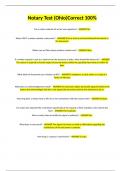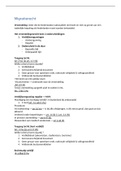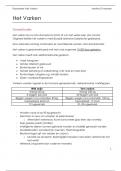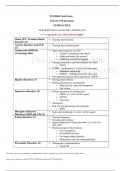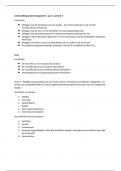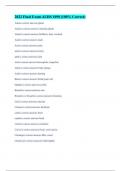generally, judges will try to uphold a trust so as to respect S’s intention: McPhail v Doulton at 450
1. establish “the three certainties”: Knight v Knight (1840) 3 Beav 148 (per Lord Langdale MR at 172-3)
i. certainty of intention - S must intent to confer the benefit of rights which she holds to B, by imposing a legally biding obligation on T to
hold said rights for B’s benefit.
NOTE that in the case of a self-declaration, S must intend that she herself will be subject to the legally binding obligations of a trustee:
Richards v Delbridge (Jessel MR)
a. intention is assessed objectively (words and conduct): Twinsectra Ltd v Yardley [2002] 2 AC 164, Challinor v Juliet Bellis & Co (a
firm);
b. language
- generally, the courts make a distinction between the use of precatory and imperative words: Lambe v Eames (1870-71) LR 6 Ch App
597 (the property was ‘to be at her disposal in any way she may think best for the benefit of herself and her family); the former
express a hope, a wish, or a moral obligation (=> gift), while the latter express a command—a duty to do something (=> power/
trust).
- the word ‘confidence’ (property left in ‘full confidence’ that donee would do the right thing) may be indicative of a trust but only if
the surrounding context also supports such a conclusion: Re Adams and the Kensington Vestry (1884) 27 Ch D 394
- BUT the presence of precatory words will not necessarily prevent the court from finding that a trust exists, as long as it is satisfied
that this was the intention of the donor: Comiskey v Bowring-Hanbury (c.f. default provision).
- NOTE the distinction between trusts & powers of disposition: Re Weekes’ Settlement [1897] 1 Ch 289 AND trusts & powers of
appointment: Re Hay’s ST [1982] 1 WLR 202
- use of the word “trust” not conclusive: Re Kayford [1974] 1 WLR 279, aff ’d Charity Commissioners for England & Wales v
Framjee;
, - a general donative intention does not suffice: Jones v Lock [1865] 1 Ch Ap 25 (a father placed a cheque for £900 in his infant son’s
hand and said “I am going to put it away for him”. the father then took the cheque and locked it away, but died six days later)
- distinguish between intention to create trust and clarifications as to who gets the property: Hilton v Cosnier [2018] EWHC 2728
(Ch) (‘I have bought it [the property] for you to live in for the rest of your life but I am not going to give it to you - it is to go to my
grandchildren’; no trust bc S had never told anyone about the “trust” and he acted inconsistent with it)
c. conduct: Paul v Constance [1977] 1 WLR 527 (‘the money is as much yours as mine’)
d. segregation of assets: Henry v Hammond [1913] 2 KB 515, Re Kayford Ltd (in liquidation) [1977] 1 WLR 527, Re Lewis’s of
Leicester Ltd [1995] 1 BCLC 514 (the separation of customers’ money in a different bank account sufficient to demonstrate an
intention to create a trust, c.f. purpose of separation);
- NOTE Barclays Bank v Quistclose Investments Ltd [1970] AC 567: a trust arises where an asset is given to somebody for a
specific purpose and if, for whatever reason, the purpose fails, the transferor may take back their asset;
e. no certainty of intention => trust fails ab initio.
ii. certainty of subject-matter - trust property must be well-defined and identifiable; ’property’ is widely interpreted, re: includes money,
goods, land, shares, covenants, debts, etc.: Swift v Dairywise Farms [2000] 1 WLR 1177; AND the proportionate amount of each B’s share
in the trust property must be identifiable: Pearson v Lehman Brothers Finance SA [2010] EWHC 2914 (Ch).
a. vague or general description of the property do not suffice: Palmer v Simmonds (1854) 2 Drew 221 (‘the bulk of my estate’)
- NOTE Re Golay’s Will Trusts [1965] 1 WLR 969 (ChD): reasonable income from my other properties’ sufficiently identifies
subject-matter (the court is used to working out what ‘reasonable’ means)
b. trusts for part of property
- goods — subject-matter uncertain unless (1) bulk is identifiable and (2) trust property is earmarked: Re London Wine Co [1986]
PCC 121, Re Goldcorp Exchange Ltd [1995] 1 AC 74.
NOTE Sale of Goods (Amendment) Act 1995, s.1(3): a purchaser of an unascertaiend part of the bulk acquires
property rights in that bulk.
, - money — where money is not segregated, it is not sufficiently certain: MacJordan Construction Ltd v Brookmount Erostin Ltd
[1992] BCLC 350 (NOTE: does this make sense when compared with the case below? is money not fungible too?)
- shares — subject-matter sufficiently certain: Hunter v Moss [1994] 1 WLR 452; NOTE that if the question relates to a portion of
shares where the shares are of different types or relate to shares in different companies, the rule in Hunter v Moss will not apply
and the trust will be void if there is no further identification of the relevant property: Re Harvard Securities Ltd (in liquidation)
[1998]
NOTE: this could be taken to mean that where the trust property is of part of a fungible bulk of intangible
property, it does not require segregation or specific identification to satisfy the certainty of subject matter
requirement.
NOTE: Briggs J in Pearson v Lehman Brothers Finance SA [2010] EWHC 2914 (Ch) — (i) trust of fungible
mass, (ii) the mass is sufficiently identifiable, (iii) B’s proportionate share in the mass is sufficiently identifiable. (the
principle is that such a trust creates a beneficial co-ownership share in the identified fund, i.e. S makes a trust out of
the whole of the bulk, e.g. 50 shares held on trust for B and the rest of the share bulk impliedly held on trust for S
themselves (equitable tenants in common);
^ in a PQ, ask whether the trust instrument may be interpreted as creating a beneficial interest in an interest
in the whole of the fund.
c. no immediate trust of future property, i.e. no trust for property that does not yet exist: Re Ellenborough [1903] 1 Ch 697
- NOTE Pearson v Lehman Brothers Finance SA [2010] EWHC 2914 (Ch): a trust will not be void for uncertainty bc the subject-
matter is, at present uncertain, if the terms of the trust are sufficient to identify the subject-matter in the future.
d. ‘anything that is left’ of the testator’s estate sufficiently certain: Re Last [1958] P 137.
e. ‘whatever is left’ of the TP after trustee dies not sufficiently certain: Sprange v Barnard (1789) 2 Bro CC 585 BUT “floating trusts”
may be allowed if the terms are taken to mean that the “trust” crystallises only on T’s death: Ottaway v Norman [1972] Ch 698.
f. no certainty of subject-matter => trust fails ab initio.
iii. certainty of objects - certainty of objects test is different for fixed trusts and discretionary trusts:
a. fixed trusts — the ‘complete list’ test = whether it is possible to identify all the beneficiaries: IRC v Broadway Cottages Trust [1955]
Ch 20;
, - e.g. OT Computers Ltd (In Administration) v First National Tricity Finance Ltd & Others [2003], an attempt to set up a trust to
protect monies owed to ‘urgent suppliers’ of a struggling company failed because the meaning to be given to the adjective ‘urgent’
was not made clear, making it impossible to draw up a full list of beneficiaries.
b. discretionary trusts — the ‘is or is not’ test = whether it can be said with certainty that any given individual is or is not a member of
the class: McPhail v Doulton (Re Baden’s Trusts (No 1)) [1971] AC 424
c. powers — the ‘is or is not’ test: Re Gulbenkian [1970] AC 508
d. conceptual uncertainty vs. evidential uncertainty:
- conceptual certainty relates to the certainty of the class; evidential certainty relates to the issue of whether or not an individual can
be found or proven to be a member of the class.
conceptual - focus is on meaning, re: is description of the class of persons whom S intends to benefit sufficiently
clear?
e.g. a trust for ‘my children’ is sufficiently clear BUT consider e.g. a trust for ‘my sons’ in circumstances where
I have biological sons and stepsons.
evidential - focus is on proof, re: to what extent does the evidence allow specific persons to be identified as members
of the relevant class?
e.g. a trust for ‘those who graduated from UCL with a law degree in 1973’ but UCL’s paper records destroyed
in a fire and no computer records: Re Sayer [1957] Ch 423 (trust for employees and ex-employees of a
company but no records to prove who was working or had worked for the company)
- if a class is conceptually uncertain, the trust will be void, but evidential uncertainty will not defeat a trust.
- NOTE gifts subject to conditions precedent = the donee will not be entitled unless they satisfy the condition, for example
‘£10,000 to each of my children who graduate from university’; a condition precedent will be valid if at least one person can be
said to satisfy the condition: Re Barlow’s WT [1979] 1 WLR 278 (testatrix provided her painting could be sold at a discount to “to
any members of my family and any friends of mine”).




